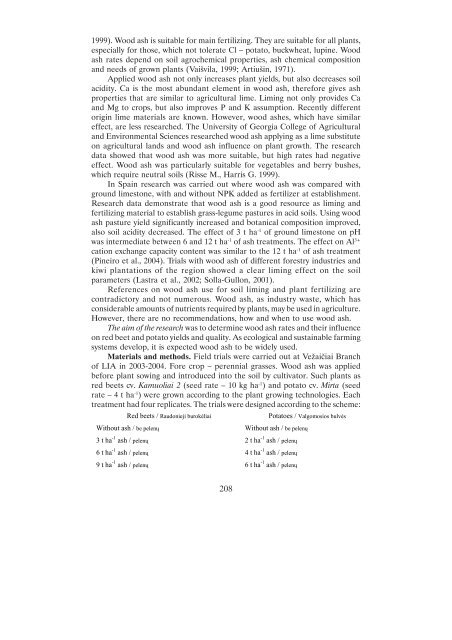SodininkystÄ ir daržininkystÄ - SodininkystÄs ir daržininkystÄs institutas
SodininkystÄ ir daržininkystÄ - SodininkystÄs ir daržininkystÄs institutas
SodininkystÄ ir daržininkystÄ - SodininkystÄs ir daržininkystÄs institutas
- No tags were found...
You also want an ePaper? Increase the reach of your titles
YUMPU automatically turns print PDFs into web optimized ePapers that Google loves.
1999). Wood ash is suitable for main fertilizing. They are suitable for all plants,especially for those, which not tolerate Cl – potato, buckwheat, lupine. Woodash rates depend on soil agrochemical properties, ash chemical compositionand needs of grown plants (Vaišvila, 1999; Artiušin, 1971).Applied wood ash not only increases plant yields, but also decreases soilacidity. Ca is the most abundant element in wood ash, therefore gives ashproperties that are similar to agricultural lime. Liming not only provides Caand Mg to crops, but also improves P and K assumption. Recently differentorigin lime materials are known. However, wood ashes, which have similareffect, are less researched. The University of Georgia College of Agriculturaland Env<strong>ir</strong>onmental Sciences researched wood ash applying as a lime substituteon agricultural lands and wood ash influence on plant growth. The researchdata showed that wood ash was more suitable, but high rates had negativeeffect. Wood ash was particularly suitable for vegetables and berry bushes,which requ<strong>ir</strong>e neutral soils (Risse M., Harris G. 1999).In Spain research was carried out where wood ash was compared withground limestone, with and without NPK added as fertilizer at establishment.Research data demonstrate that wood ash is a good resource as liming andfertilizing material to establish grass-legume pastures in acid soils. Using woodash pasture yield significantly increased and botanical composition improved,also soil acidity decreased. The effect of 3 t ha -1 of ground limestone on pHwas intermediate between 6 and 12 t ha -1 of ash treatments. The effect on Al 3+cation exchange capacity content was similar to the 12 t ha -1 of ash treatment(Pine<strong>ir</strong>o et al., 2004). Trials with wood ash of different forestry industries andkiwi plantations of the region showed a clear liming effect on the soilparameters (Lastra et al., 2002; Solla-Gullon, 2001).References on wood ash use for soil liming and plant fertilizing arecontradictory and not numerous. Wood ash, as industry waste, which hasconsiderable amounts of nutrients requ<strong>ir</strong>ed by plants, may be used in agriculture.However, there are no recommendations, how and when to use wood ash.The aim of the research was to determine wood ash rates and the<strong>ir</strong> influenceon red beet and potato yields and quality. As ecological and sustainable farmingsystems develop, it is expected wood ash to be widely used.Materials and methods. Field trials were carried out at Veþaièiai Branchof LIA in 2003-2004. Fore crop – perennial grasses. Wood ash was appliedbefore plant sowing and introduced into the soil by cultivator. Such plants asred beets cv. Kamuoliai 2 (seed rate – 10 kg ha -1 ) and potato cv. M<strong>ir</strong>ta (seedrate – 4 t ha -1 ) were grown according to the plant growing technologies. Eachtreatment had four replicates. The trials were designed according to the scheme:Red beets / Raudonieji burokëliaiPotatoes / Valgomosios bulvësWithout ash / be pelenøWithout ash / be pelenø3 t ha -1 ash / pelenø 2 t ha -1 ash / pelenø6 t ha -1 ash / pelenø 4 t ha -1 ash / pelenø9 t ha -1 ash / pelenø 6 t ha -1 ash / pelenø208
















